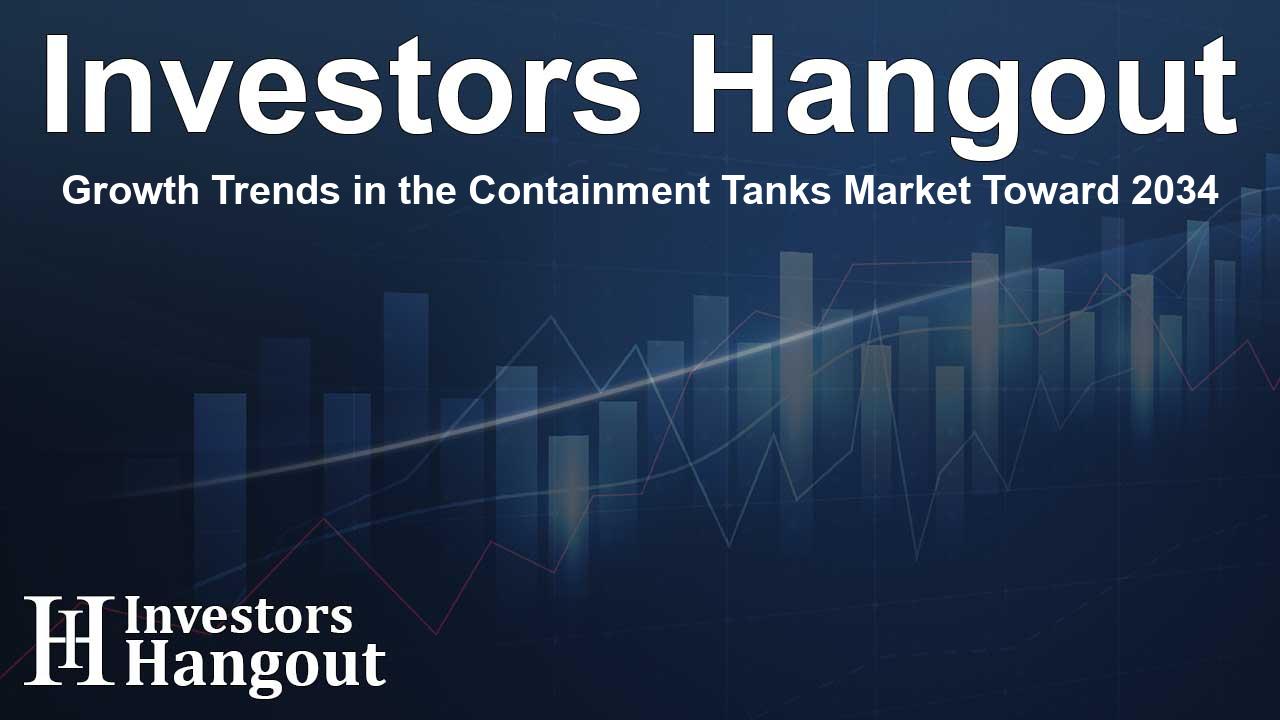Growth Trends in the Containment Tanks Market Toward 2034

Understanding the Growth of the Containment Tanks Market
The containment tanks market is on the rise, with expectations to reach a remarkable value of approximately US$ 9.6 billion by 2034. Currently valued at around US$ 6.1 billion, the market is projected to grow at a steady CAGR of 4.7%. This growth is a testament to the increasing importance of secure storage solutions across various industries.
Importance of Containment Tanks Across Industries
Containment tanks are essential for safely storing hazardous materials, including chemicals, wastewater, oil, and fuels. These tanks play a crucial role in ensuring that environmental contamination is minimized, effectively controlling spills and complying with stringent regulations. Major industries, such as oil and gas, pharmaceuticals, and food and beverage, significantly depend on these storage solutions to operate safely and protect public health.
Driving Factors Behind Market Growth
Industrial growth and infrastructure developments have led to an increased demand for effective containment solutions. The ongoing advancements in materials, designs, and monitoring technologies have also contributed to the development of more efficient, durable, and economically viable containment tanks. Additionally, heightened awareness of environmental safety and the necessity for compliance with regulatory standards amplify the need for these tanks.
Key Market Takeaways
- The containment tanks market is projected to see a CAGR of 4.7% by 2034.
- From 2024 to 2034, an opportunity of US$ 3.5 billion is expected.
- North America is anticipated to hold a significant market share, with projections of 1% by 2034.
- Major players in the industry include Tank Connection, Snyder Industries, and Emerson Electric Co., among others.
- Double-wall tanks are expected to witness notable growth, suggesting a broader acceptance and need for enhanced safety measures.
Technological Advancements and Innovations
Technological advancements are shaping the future of containment tanks. Innovations in design and production processes are improving product efficiency and effectiveness. These improvements reassure businesses investing in containment solutions that they are compliant with eco-regulations and can respond effectively to emergencies.
Industry Developments and Strategic Moves
Companies in the containment tanks market are adopting various strategies to expand their presence and enhance product offerings. Recent expansions have taken shape through various means, including acquisitions and facility upgrades.
For instance, a recent expansion completed by Hughes Tank Company aims to grow their manufacturing capabilities significantly. Such expansions not only boost production but also address the increasing demand for high-quality storage solutions tailored to diverse industries, ranging from petroleum to agriculture.
Recent Industry News
Another noteworthy development in the industry includes the acquisition of Highland Tank by TerraVest Industries Inc. This strategic move is anticipated to also strengthen Granby Industries' competitiveness within the containment tanks market. These developments reflect the ongoing consolidation and strategic positioning within the market, allowing companies to better cater to evolving customer needs and regulatory pressures.
The Future of the Containment Tanks Market
As industries continue to scale while adhering to increasingly rigorous safety and environmental standards, the demand for effective containment tanks is bound to rise. Ongoing efforts to innovate and improve these systems will play a crucial role in assuring safety and compliance across multiple sectors. The future outlook for the containment tanks market is bright, with continuous improvements leading to enhanced functionalities, paving the path for more secure and reliable solutions.
Frequently Asked Questions
What is driving the growth of the containment tanks market?
The growth is primarily driven by industrial expansion, environmental safety regulations, and advancements in containment technology.
What role do containment tanks play in industry?
They are essential for securely storing hazardous materials and preventing environmental contamination, crucial for public health and compliance.
Who are the key players in the containment tanks market?
Major players include Tank Connection, Snyder Industries, and Emerson Electric Co., all contributing to innovation in the sector.
What is the projected market value by 2034?
The containment tanks market is projected to reach approximately US$ 9.6 billion by 2034.
Why is double-wall tank technology significant?
Double-wall tanks enhance safety by providing an additional layer of protection against leaks and spills, crucial for hazardous materials.
About The Author
Contact Dylan Bailey privately here. Or send an email with ATTN: Dylan Bailey as the subject to contact@investorshangout.com.
About Investors Hangout
Investors Hangout is a leading online stock forum for financial discussion and learning, offering a wide range of free tools and resources. It draws in traders of all levels, who exchange market knowledge, investigate trading tactics, and keep an eye on industry developments in real time. Featuring financial articles, stock message boards, quotes, charts, company profiles, and live news updates. Through cooperative learning and a wealth of informational resources, it helps users from novices creating their first portfolios to experts honing their techniques. Join Investors Hangout today: https://investorshangout.com/
The content of this article is based on factual, publicly available information and does not represent legal, financial, or investment advice. Investors Hangout does not offer financial advice, and the author is not a licensed financial advisor. Consult a qualified advisor before making any financial or investment decisions based on this article. This article should not be considered advice to purchase, sell, or hold any securities or other investments. If any of the material provided here is inaccurate, please contact us for corrections.
